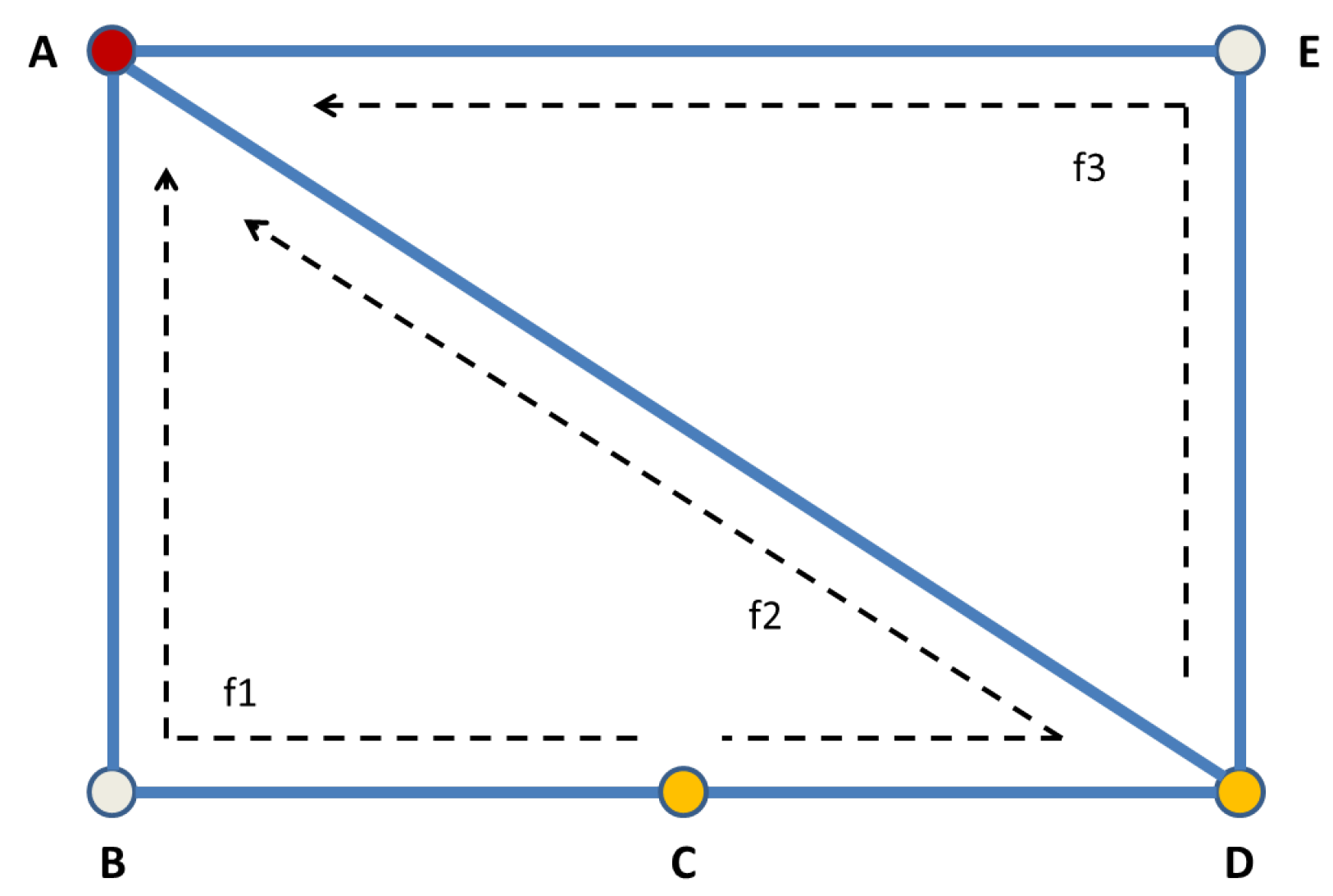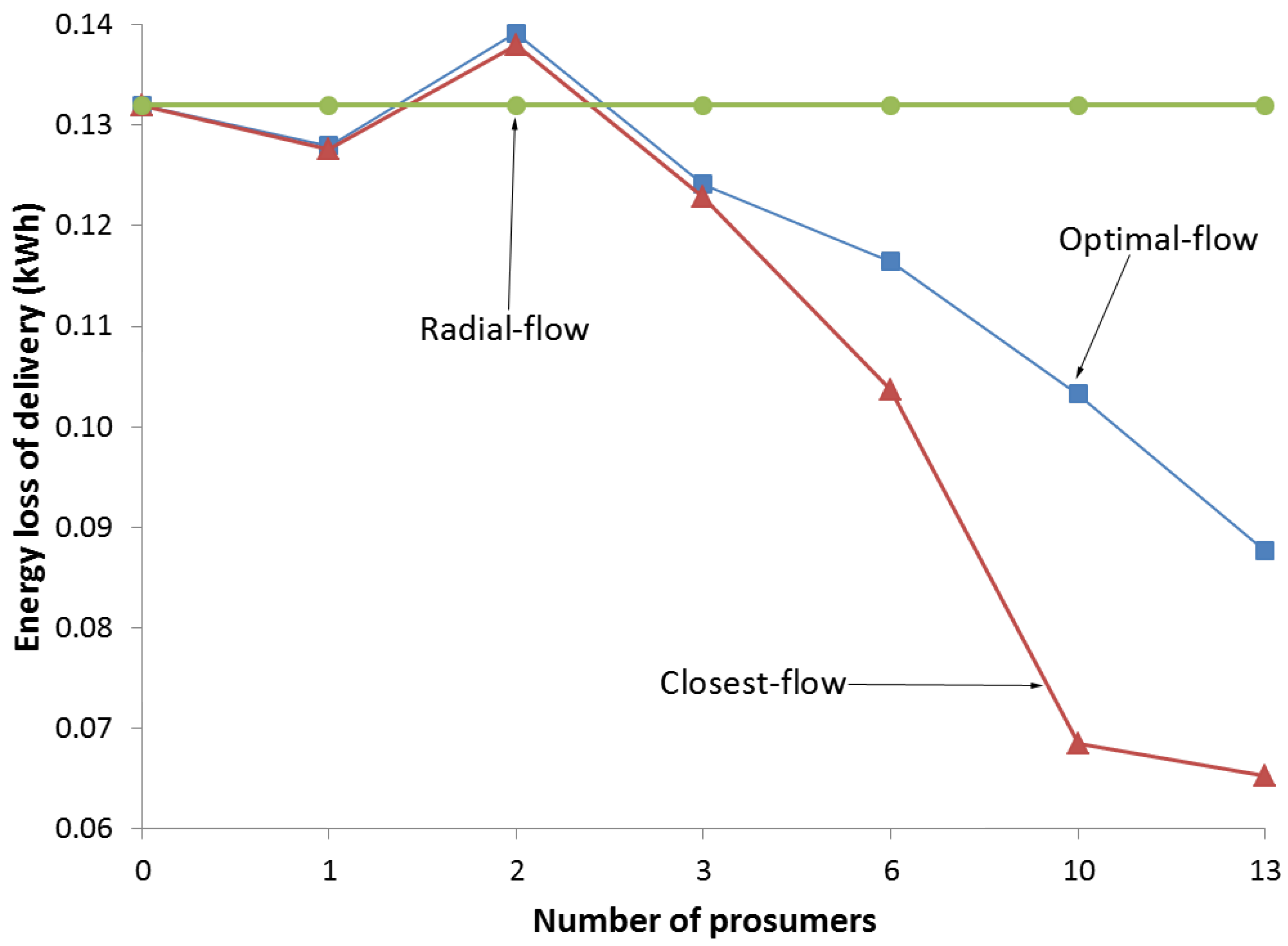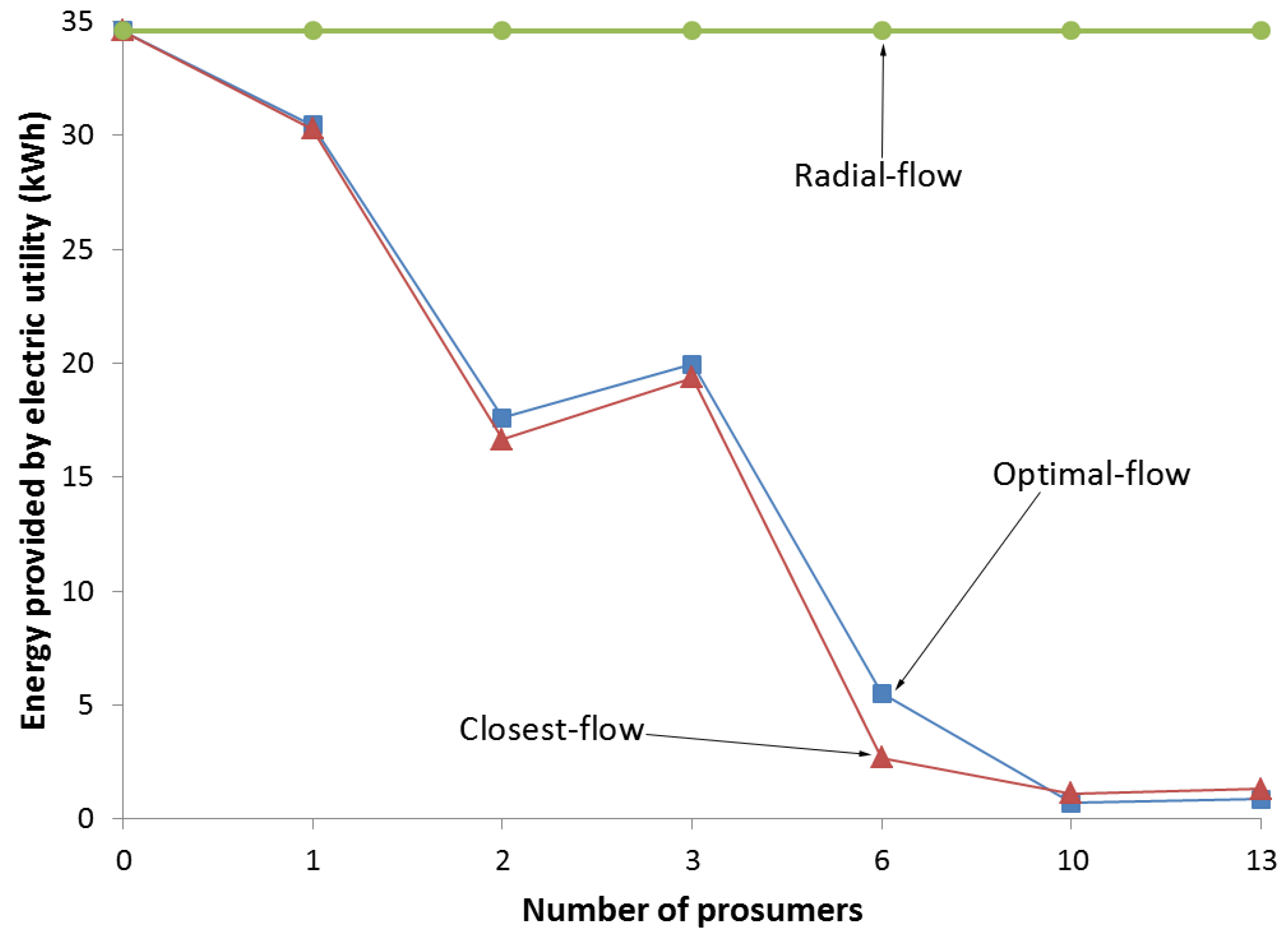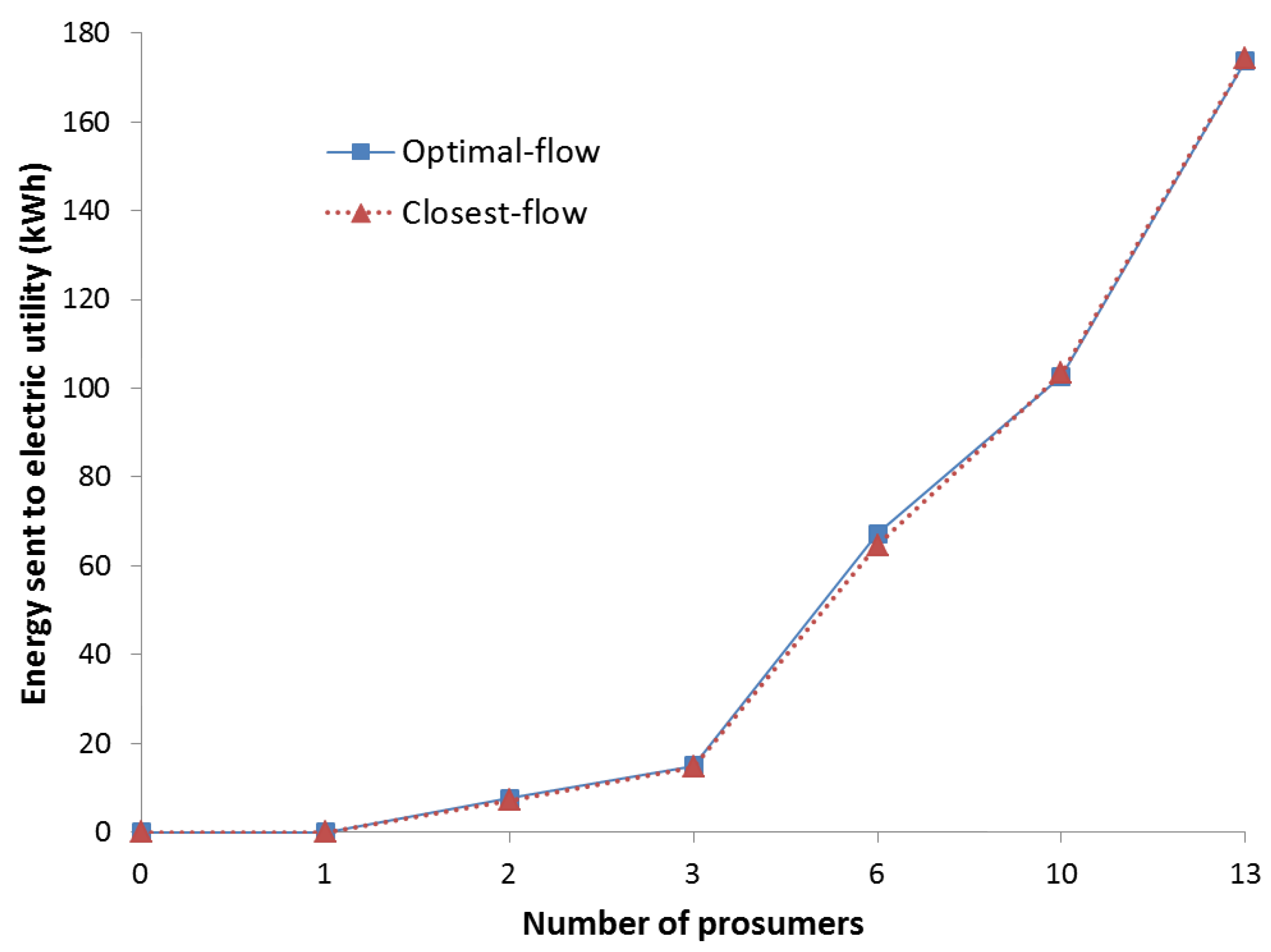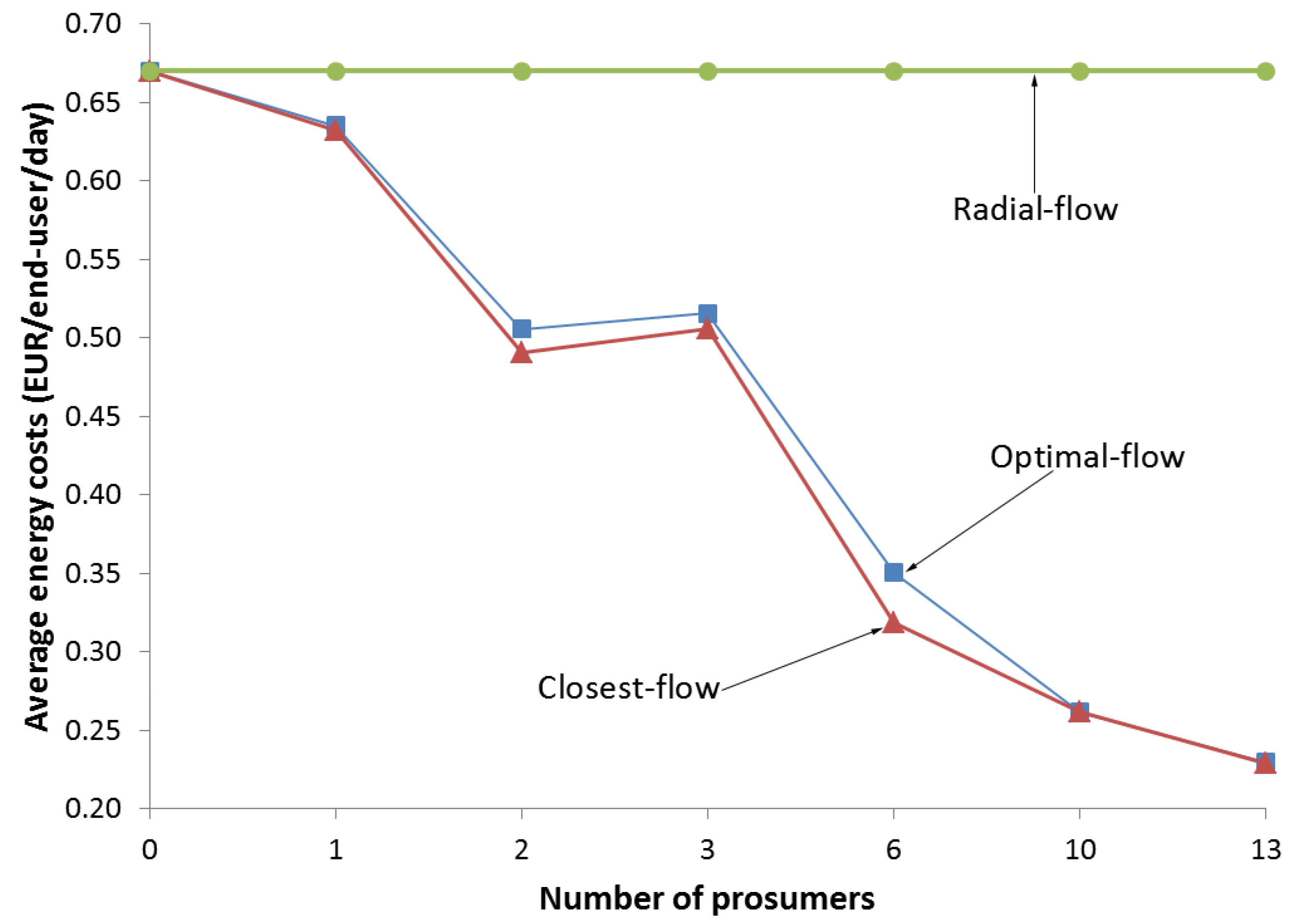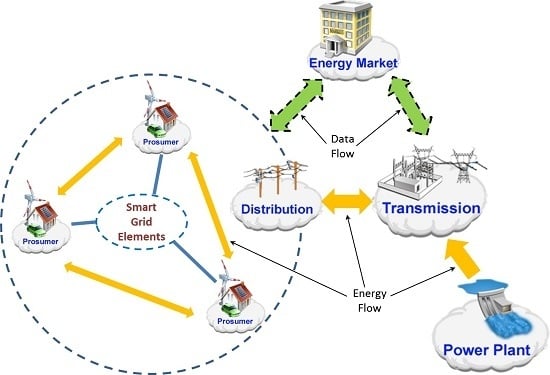6.1. Evaluation Cases
We consider three evaluation cases based on different energy flow patterns. The first one is a
Radial-flow Case that simulates the traditional energy distribution flow. Electrical energy goes from the electric utility (central provider) to all end-users in the test feeder. In this case, there are no prosumers. All end-users are consumers and all energy consumption in the test feeder is supplied by the electric utility. The electric utility injects energy into the test feeder via Node 650 in
Figure 2. The energy is delivered to other end-users from this node. Node 650 is also an end-user but energy loss of delivering energy to this node is 0.
The second evaluation case is the
Optimal-flow Case. It simulates the model and solution of the Prosumer-involved Smart Grid proposed in this paper. Some of end-users are prosumers; energy production and decentralised energy exchange are involved. The optimisation strategy of decentralised energy exchange in this case is based on
Section 4.
The last case is the Closest-flow Case. It is based on the Optimal-flow Case with a minor adjustment to the energy flow pattern. In this case, prosumers, energy production and decentralised energy exchange are involved as the Optimal-flow Case. Though there is a difference in the optimisation strategy. When finding the optimal providers in Algorithm 4, we select the providers that offer the lowest price without considering the cost of energy loss. These providers are the contract providers that actually receive the payments from the consumer. When planning energy flows, we select the providers with the shortest distance to the consumer. These selected providers are the transit providers that actually transmit electrical energy to the consumer but they do not get any payment. The shortest distance means the minimum number of electric lines from a source node to a destination node. This energy flow pattern is close to the realistic situation when transmitting electrical energy in the test feeder. Thus, the step of getting weight in Line 15 of Algorithm 2 is modified. We set the weight of each arc to 1 instead of . The contract provider and the transit provider can be the same node or can be two different nodes. Therefore, it is possible that some providers are paid without exporting their energy and some providers export their energy without any payment.
6.2. Assessment Metrics, Baseline and Simulation Setting
To verify the effectiveness of the proposed solution, we design five assessment metrics. These are energy loss of delivery, energy provided by the electric utility, proportion of energy self-satisfaction in the test feeder, excess energy sent to the electric utility, and average energy costs per end-user. We used the Radial-flow Case (traditional power system) as a baseline to assess other two evaluation cases based on our solution.
To assess the influence of the prosumer, we set various number of prosumers for the Optimal-flow Case and the Closest-flow Case in the simulation. The number of prosumers is . This means that of the end-users are prosumers. When the number of prosumers is , the Optimal-flow Case and the Closest-flow Case equal the Radial-flow Case. For the Radial-flow Case, the number of prosumers is always 0 that dose not influence the simulation results.
In order to analyse simulation data, we ran multiple instances of the simulation and calculated the mean values of all outputs for the metrics [
37]. We set the number of simulation runs per configuration to
. That is, we ran the simulation for
days and calculated the mean values for all outputs of these days for each evaluation metric. In these
days, each day was randomly selected from four seasons in a year. Therefore, the seasonal effects are represented in our simulation. In each iteration, each case run once. Three evaluation cases share same generated data of energy consumption and energy prices offered by the electric utility. The Optimal-flow Case and the Closest-flow Case share the same generated data for energy production and energy prices offered by prosumers. In each iteration, the number of time slot was
and
h. To avoid conflicts that several consumers buy energy from one provider at the same time, the running of each end-user is isolated, independent and sequential. The sequence of running end-users was random at different each time slot. But at the same time slot, the sequences of running end-users for three evaluation cases were the same.
6.3. Discussion
One aim of our study is to decrease energy loss of delivery in the test feeder. The performance of energy loss reduction is shown in
Figure 3. For the Optimal-flow Case and the Closest-flow Case, the overall trend of energy loss is decreasing with the increase of the number of prosumers. Energy loss in this figure is based on transmitting the same amount of energy in the three evaluation cases. For the Optimal-flow Case and the Closest-flow Case, the loss of buying energy from prosumers and the loss of buying energy from the electric utility are both counted. With the rising number of prosumers, the amount of energy transmitted from the electric utility decreases (shown in
Figure 4 and
Figure 5) and the amount of energy flowing as the proposed solution increases. Then, the efficiency of energy loss reduction in the test feeder is improved. This finding means that the solution proposed in this study outperform the baseline (traditional power system) in reducing energy loss of delivery.
In
Figure 3, there are peaks of energy loss for both the Optimal-flow Case and the Closest-flow Case and the peaks are beyond the baseline. This happens when the number of prosumers, denoted by
M, is 2. This can be explained with the consumers’ preference to buy energy from prosumers in our simulation. Consumers still would buy energy from prosumers when the energy loss of buying energy from prosumers is greater than the cost of buying energy from the electric utility. When
, the influence of the case mentioned above is significant. This can cause the increase of energy loss. For example, if we assume that the prosumers are Node 634 and Node 646, and one of consumers is Node 611; that energy from the electric utility is injected via Node 650, then for Node 611, buying energy from Node 634 or Node 646 obviously has more energy losses than from the electric utility. When
, there is only about
of energy in the test feeder provided by the prosumer (shown in
Figure 4). Compared to
of energy provided by the prosumers when
, the influence of the case mentioned above is limited. When
, there are more choices for consumers to select prosumers. Therefore, the consumers are able to buy energy from the prosumers with lower energy loss than the situation of
.
Comparing to the traditional power system, the Prosumer-involved Smart Grid has a considerable advantage in terms of improving independence from centralised energy generation and central energy providers,
Figure 4. The upward trend in proportion of energy self-satisfaction is shown in
Figure 4. In this figure, the proportion of energy that provided by prosumers to the total energy consumption increases with the rising number of prosumers in both cases of the Optimal-flow and the Closest-flow. Because the increasing number of prosumers causes the increase of distributed energy generation and decentralised energy exchange among end-users. For the Radial-flow Case (i.e., baseline), the energy self-satisfaction is always 0, overlapping with the
X axis. On the contrary, energy provided by the electric utility decreases when we add prosumers. This can be observed in
Figure 5. The reason of this descending trend is the same as the reason of the ascending trend of energy self-satisfaction. Moreover, the results of the Optimal-flow Case and the Closest-flow Case are lower than the baseline. This finding supports that the solution improves independence from centralised energy generation and central energy providers.
We also measured the excess energy that is sent to the electric utility. The excess energy shown in
Figure 6 is prosumers’ energy that is not sold or transmitted to other end-users. For the Radial-flow Case (i.e., baseline), the excess energy is always 0, overlapping with the
X axis. For other two cases, it significantly increases with the number of prosumers. The reason of this ascending trend is similar to the one of energy self-satisfaction. Besides, most parts of the two curves in
Figure 6 overlap. It means that different patterns of energy flows have no influence on this metric.
Another aim of our study is to save energy costs for end-users. The energy cost is the total amount of money paid by the end-user for buying energy over a day. The results in
Figure 7 show a dropping trend of average energy costs per end-user with the rising number of prosumers. The results of the Optimal-flow Case and the Closest-flow Case are both lower than the baseline. Since the price formation is beyond the scope of this paper, we simply consider that the renewable energy produced by prosumers has different prices from the energy provided by the electric utility; grid fees, accounting risks, structuring of profiles and taxes are considered to be fixed. Thus, renewable energy produced by prosumers is sold with lower price than energy provided by the electric utility in the Prosumer-involved Smart Grid. Therefore, energy costs of end-users are reduced when more prosumers are involved in the test feeder and more renewable energy is exchanged among end-users.
The figures give an indication of the overall performance of the Optimal-flow Case and the Closest-flow Case and how these significantly improve on the current baseline (i.e., the Radial-flow Case). To clearly indicate the improvement, numerical data of the evaluation based on four metrics are shown in
Table 2. We calculate the percentage of the maximum reduction based on the baseline for three metrics, including energy loss of delivery, average energy costs and energy provided by the electric utility. The maximum values of energy self-satisfaction proportion are also shown in this table. Compared to the baseline, the maximum reduction of energy loss is
achieved by the Closest-flow Case. The Optimal-flow Case maximumly reduces energy provided by the electric utility by
. It also obtains the maximum proportion of energy self-satisfaction that is
. The maximum reduction of average energy costs per end-user is
achieved in both cases.
To compare the Optimal-flow Case with the Closest-flow Case, based to the data in
Table 2, we design
Figure 8. The figure highlights how these two evaluation cases have the same performance in the maximum reduction of average energy costs per end-user. They also have very close performance in the maximum reduction of energy provided by the electric utility and the maximum proportion of energy self-satisfaction. However, the Optimal-flow Case slightly exceeds the Closest-flow Case in these two metrics. On the other hand, the Closest-flow Case significantly outperforms the Optimal-flow Case in energy loss of delivery.
For energy loss of delivery, the Closest-flow Case obviously outperforms the Optimal-flow Case in
Figure 3 and
Figure 8. The reason of this outcome is linked to the use of a radial test feeder to test the solution. As described in
Section 6.1, the energy flow pattern of the Closest-flow Case approximates to the realistic situation when delivering energy in the test feeder. In the realistic situation, the test feeder has the radial topology. Thus, the Closest-flow Case is designed for the radial test feeder. It may therefore have better performance than the Optimal-flow Case in this test feeder. However, the ideal test platform for the Optimal-flow Case is a test feeder with a more meshed topology. In the radial network, there is only one path between each pair of nodes. This negatively influences the optimisation of delivery paths proposed in
Section 4.3. For example, if in
Figure 2 Node 634 transmits energy to Node 611, the energy flow travels on the longest path in the test feeder and blocks energy transit between other nodes. The blocked consumers have to buy energy from the electric utility. This may increase energy loss of delivery. When the number of prosumers rises, the number of nodes involved in decentralised energy exchange increases. Then, the negative influence of the radial topology may therefore become apparent.
